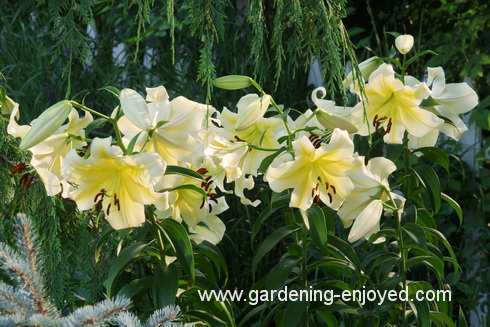
This is why I fight with the Red Lily Beetle. This is an Orienpet hybrid Lily called Golden Stargazer and she is always a sensation when it’s her turn to show up in the garden. The stalks are about 1.3 m tall and this clump is probably from 3 bulbs planted a few years ago. I actually didn’t notice a lot of red beetles this year, maybe the more I kill, the fewer there are to survive the winter. Having said that will almost guarantee a swarm next year ☺ There are several other lovely clumps of Lily in bloom throughout the garden. Many many years ago one of my summer jobs at University was working for the Lily Breeder at the U of Guelph and I planted and tended a wide range of Lilies and have been in love with them ever since. There were no Red Lily Beetles back then. I caught this picture as the sun was dropping and strongly backlighting these
delights.
As I hit the save button, I see that I seem to be “Dallying” about once a month instead of the weekly that used to be the schedule. I’m sure the passing years have nothing to do with that.
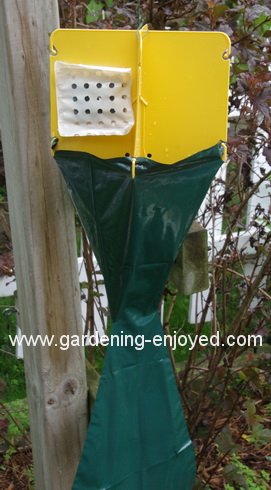 This is my Japanese Beetle trap. It seems to be catching a good quantity of those nasty bugs but certainly not all of them. We had no Gypsy Moth caterpillars here but this trap always seems to have a number of the moths flying around it. A couple of my Roses are being regularly attacked by the Japanese Beetles but luckily the first flush of bloom was finished on most of them. I find some everyday on the Asparagus and the leaves of the Eggplant. Maybe they need their three servings of vegetables every day as well. I wander the garden every morning carrying a spray bottle of Trounce which is mostly insecticidal soap with a little pyrethrum, one of the few weapons that we have available. It is, of course, a contact spray meaning that you actually have to hit the live bug with it, there is no residual effect. That’s why I’m comfortable spraying it near
my veggies.
This is my Japanese Beetle trap. It seems to be catching a good quantity of those nasty bugs but certainly not all of them. We had no Gypsy Moth caterpillars here but this trap always seems to have a number of the moths flying around it. A couple of my Roses are being regularly attacked by the Japanese Beetles but luckily the first flush of bloom was finished on most of them. I find some everyday on the Asparagus and the leaves of the Eggplant. Maybe they need their three servings of vegetables every day as well. I wander the garden every morning carrying a spray bottle of Trounce which is mostly insecticidal soap with a little pyrethrum, one of the few weapons that we have available. It is, of course, a contact spray meaning that you actually have to hit the live bug with it, there is no residual effect. That’s why I’m comfortable spraying it near
my veggies.
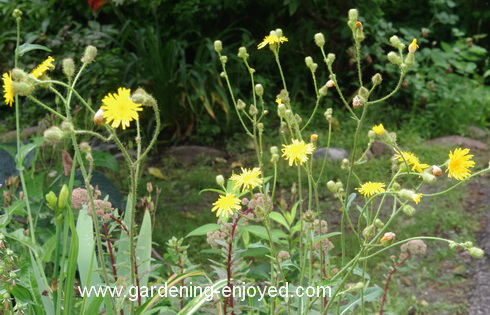
This picture almost looks like a desirable flower but it is actually the bloom of one of my worst weeds the Perennial Sow Thistle Sonchus arvensis. It grows from extensive deep white roots and every time you pull one of them some of the root stays behind to start the next plant. These flowers are towering over most other things in the perennial garden and are showing the, knowledgeable, world how poorly I have been doing at keeping up with the weeding. As the last few weeks have provided a study supply of rain, many things in the garden, including the weeds, have been thriving. I confess that I don’t like weeding the garden while Mother Nature is watering it, leaving the weeds adequate time to thrive.
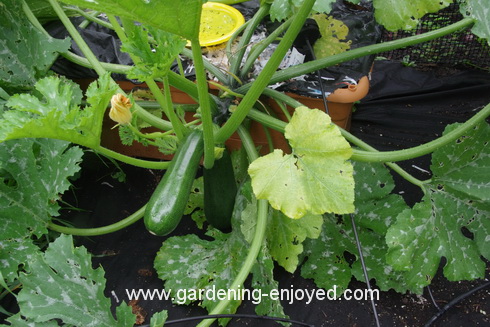
Speaking of things thriving, anybody want a few Zucchini? This one is a new variety, Astia, from Renee’s Seeds that was bred to grow in containers and its compact size belies its ability to produce fruit in amazing quantities. Of course, I planted four of them when it appears that one would have been sufficient. The fruit in the picture is as big as I allow them to grow before they head for the dinner table, where we have tried all of our regular recipes and have gone searching for more. Try Googling “uses for Zucchini” and see how may thousand hits you get. I also have a few Patty Pan summer Squash plants producing at the same rate and I try to pick them when they are about 3 cm in diameter and steam them whole. They are quite tasty and look great on the dinner plate. Some day I may learn about planting the correct quantity. The Assistant gardener frequently points out that the 5
children left home years ago and I don’t need to keep trying to feed all of them.
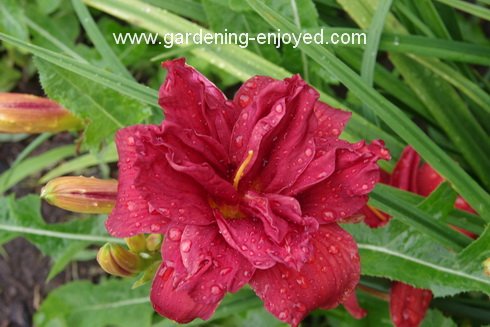 Mid summer is also Daylily season. These delights have to be one of the lowest maintenance perennials, essentially no bugs or diseases and they can be happy and contained in their garden location for many years. The one above is Double Firecracker and the four below are just to illustrate the range of bloom types and some of the colours. There is no blue and no true white although a few come closer to white. Daylilies are very hardy and easy to move and divide and you can do that at almost anytime and they will survive. Now if they would just bloom at a different time from the Lilies they would be perfect, although most of them are still blooming when the Lilies have finished.
Mid summer is also Daylily season. These delights have to be one of the lowest maintenance perennials, essentially no bugs or diseases and they can be happy and contained in their garden location for many years. The one above is Double Firecracker and the four below are just to illustrate the range of bloom types and some of the colours. There is no blue and no true white although a few come closer to white. Daylilies are very hardy and easy to move and divide and you can do that at almost anytime and they will survive. Now if they would just bloom at a different time from the Lilies they would be perfect, although most of them are still blooming when the Lilies have finished.
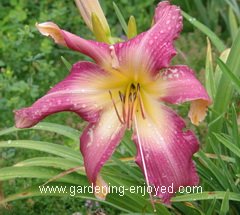
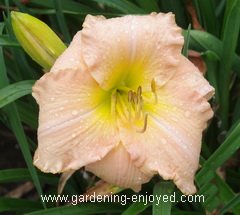
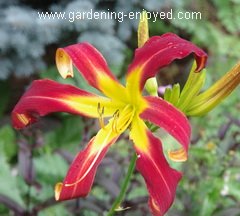
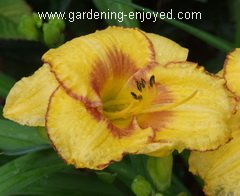
I have become quite comfortable doing my presentations on Zoom and one of the big advantages is the ability to speak to groups that are too far away to travel to. I will admit to missing the feel of a live audience but we will continue to Zoom to your meetings as long as we have to. Maybe the long distance capability will be one of the few positive things to develop out of this pandemic. If your group is looking for a knowledgeable and entertaining speaker, check out my web site’s, speaker page.
To ask a question just “reply” to this ezine. Don’t forget to check the front page of the Website for frequent short ideas for current gardening activities.
Ann Asks? Some good advice from a reader. “I have found the solution to my Japanese beetle invasion. Last month I bought a hand held vacuum with a crevice tool and it is
perfect. Turn on the vacuum, suck up the beetles, and then flip down the spout so they can't get out. I pruned my big rose bush so it is easy to reach now, and it may flower again once beetle season is over.” I will spray nematodes again mid to late August....is that too early?
Ken Answers! Vacuum looks like fun. I use a small sprayer with Trounce in it and then knock them into a bucket. Late August to September is the time for nematodes on the lawn.
Shirley Asks?Last Fall, I planted two Itoh Peonies. They both came up in the spring and one is growing well, but the other was showing light green leaves with darker green veining. To my mind, it was lacking fertilizer, so I applied some 4-12-8 (Rhododendron fertilizer), around the base - (though not close to the stems).
A few weeks passed with no change in the light leaves with dark veining. Now, I see new growth which is pure white - no sign of green. They were planted about 4 ft
apart, in soil mix and compost. I would have thought by this time, the fertilizer would have helped the pale leaves, but instead the new growth has no colour at all. I have grown Tree and Itoh Peonies for many years and have never experienced pale leaves, nor white new growth. I checked the Internet, but could find nothing helpful there. Any ideas?
Ken Answers! You were describing interveinal chlorosis, until the all white leaves showed up, which can be the result of several nutrient deficiencies usually Iron or Magnesium. If it’s new leaves it is probably Iron. There is usually lots of Iron in the soil but its uptake can be inhibited by several factors including high soil ph or high Phosphorus levels which you may have contributed to with your choice of fertilizer. Do a little research on iron deficiency to understand what might be happening.
|

 This is my Japanese Beetle trap. It seems to be catching a good quantity of those nasty bugs but certainly not all of them. We had no Gypsy Moth caterpillars here but this trap always seems to have a number of the moths flying around it. A couple of my Roses are being regularly attacked by the Japanese Beetles but luckily the first flush of bloom was finished on most of them. I find some everyday on the Asparagus and the leaves of the Eggplant. Maybe they need their three servings of vegetables every day as well. I wander the garden every morning carrying a spray bottle of Trounce which is mostly insecticidal soap with a little pyrethrum, one of the few weapons that we have available. It is, of course, a contact spray meaning that you actually have to hit the live bug with it, there is no residual effect. That’s why I’m comfortable spraying it near
my veggies.
This is my Japanese Beetle trap. It seems to be catching a good quantity of those nasty bugs but certainly not all of them. We had no Gypsy Moth caterpillars here but this trap always seems to have a number of the moths flying around it. A couple of my Roses are being regularly attacked by the Japanese Beetles but luckily the first flush of bloom was finished on most of them. I find some everyday on the Asparagus and the leaves of the Eggplant. Maybe they need their three servings of vegetables every day as well. I wander the garden every morning carrying a spray bottle of Trounce which is mostly insecticidal soap with a little pyrethrum, one of the few weapons that we have available. It is, of course, a contact spray meaning that you actually have to hit the live bug with it, there is no residual effect. That’s why I’m comfortable spraying it near
my veggies. Mid summer is also Daylily season. These delights have to be one of the lowest maintenance perennials, essentially no bugs or diseases and they can be happy and contained in their garden location for many years. The one above is Double Firecracker and the four below are just to illustrate the range of bloom types and some of the colours. There is no blue and no true white although a few come closer to white. Daylilies are very hardy and easy to move and divide and you can do that at almost anytime and they will survive. Now if they would just bloom at a different time from the Lilies they would be perfect, although most of them are still blooming when the Lilies have finished.
Mid summer is also Daylily season. These delights have to be one of the lowest maintenance perennials, essentially no bugs or diseases and they can be happy and contained in their garden location for many years. The one above is Double Firecracker and the four below are just to illustrate the range of bloom types and some of the colours. There is no blue and no true white although a few come closer to white. Daylilies are very hardy and easy to move and divide and you can do that at almost anytime and they will survive. Now if they would just bloom at a different time from the Lilies they would be perfect, although most of them are still blooming when the Lilies have finished.




